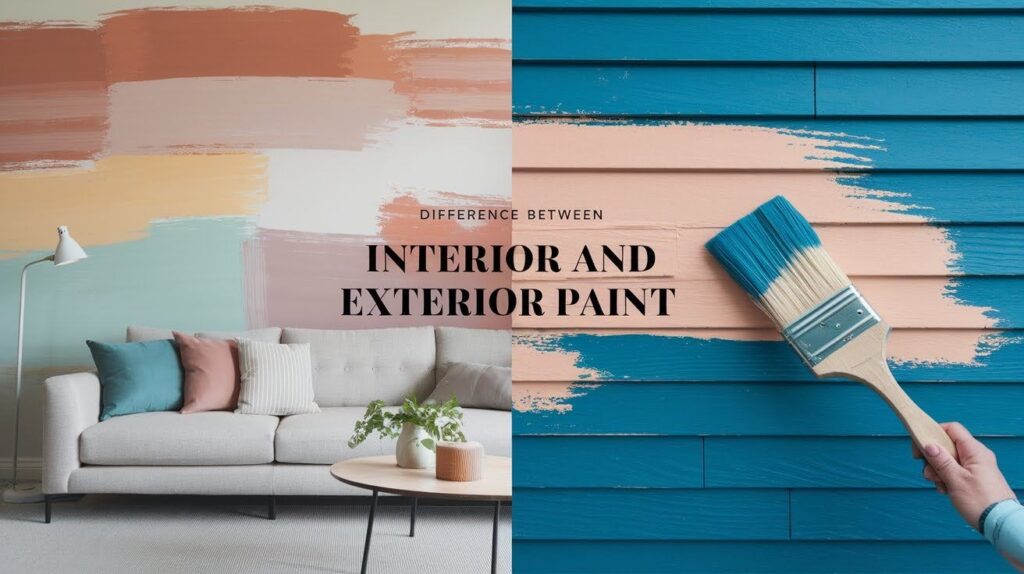When I first started painting my home, I made the mistake of using leftover exterior paint for my living room walls. The results were disappointing, and I quickly learned that not all paints are created equal.
Selecting the right paint isn’t just about color; it’s about understanding that interior and exterior formulas serve completely different purposes.
Interior paints focus on washability, low odor, and smooth finishes for comfortable living spaces. Exterior paints prioritize weather resistance, UV protection, and durability against harsh conditions.
I’ve spent years learning these differences the hard way, and I want to save you from the same costly mistakes.
In this guide, I’ll break down exactly when to use each type of paint, what makes them different, and how to choose the perfect option.
Ready to become a smarter paint shopper? Let’s get started.
Interior Paint: Composition, Properties, And Characteristics
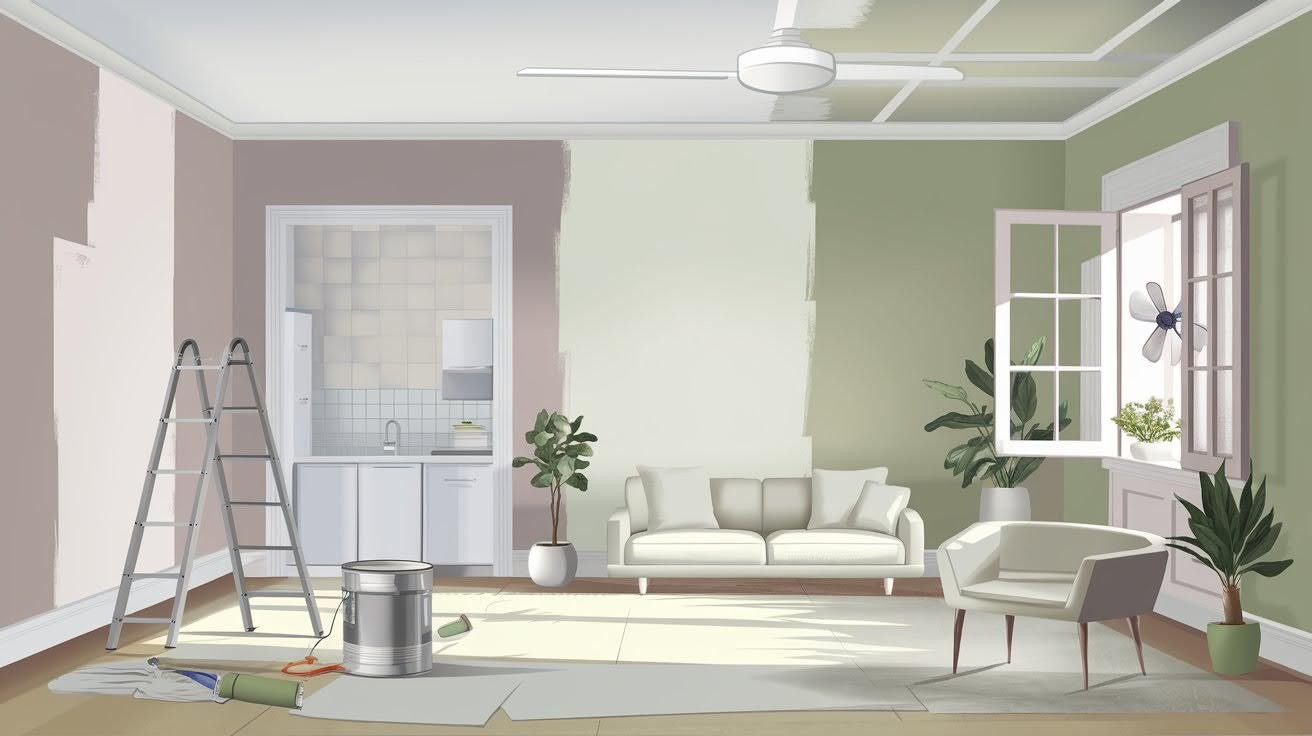
Interior paints are specially made for indoor spaces with ingredients that focus on comfort, safety, and easy maintenance.
Key Ingredients In Interior Paint
I always check the label when buying interior paint. Here’s what you’ll find inside:
Binders hold everything together. They’re usually acrylic or latex resins. These create the film that sticks to your walls.
Pigments give you color. Titanium dioxide makes white paint white. Other pigments create different shades. Solvents keep the paint liquid. Water-based paints use water. Oil-based paints use mineral spirits.
Additives do special jobs. Some prevent mold. Others make paint flow better. Some reduce odors.
Durability And Finish Options
I’ve tested many interior paints over the years.
They come in five main finishes: Flat paint hides wall imperfections well. But it’s hard to clean. I use it on ceilings mostly. Eggshell has a slight shine. It’s easier to wipe down than flat paint.
Here’s the thing, though.
Satin works great in kitchens and bathrooms. It handles moisture and cleaning better. Semi-gloss is my go-to for trim and doors. It’s durable and wipes clean easily. Gloss paint is the toughest. But it shows every flaw on your walls.
Health And Safety Considerations
Indoor air quality matters. I always pick paints with low VOCs (volatile organic compounds). VOCs cause headaches and breathing problems. They smell strong too.
But here’s what most people don’t know.
Even “safe” paints need good air flow while drying. I always open windows and run fans when painting indoors.
Children and pregnant women should stay away from fresh paint fumes. Wait at least 24 hours before letting them back in the room.
Exterior Paint: Composition, Properties, And Characteristics
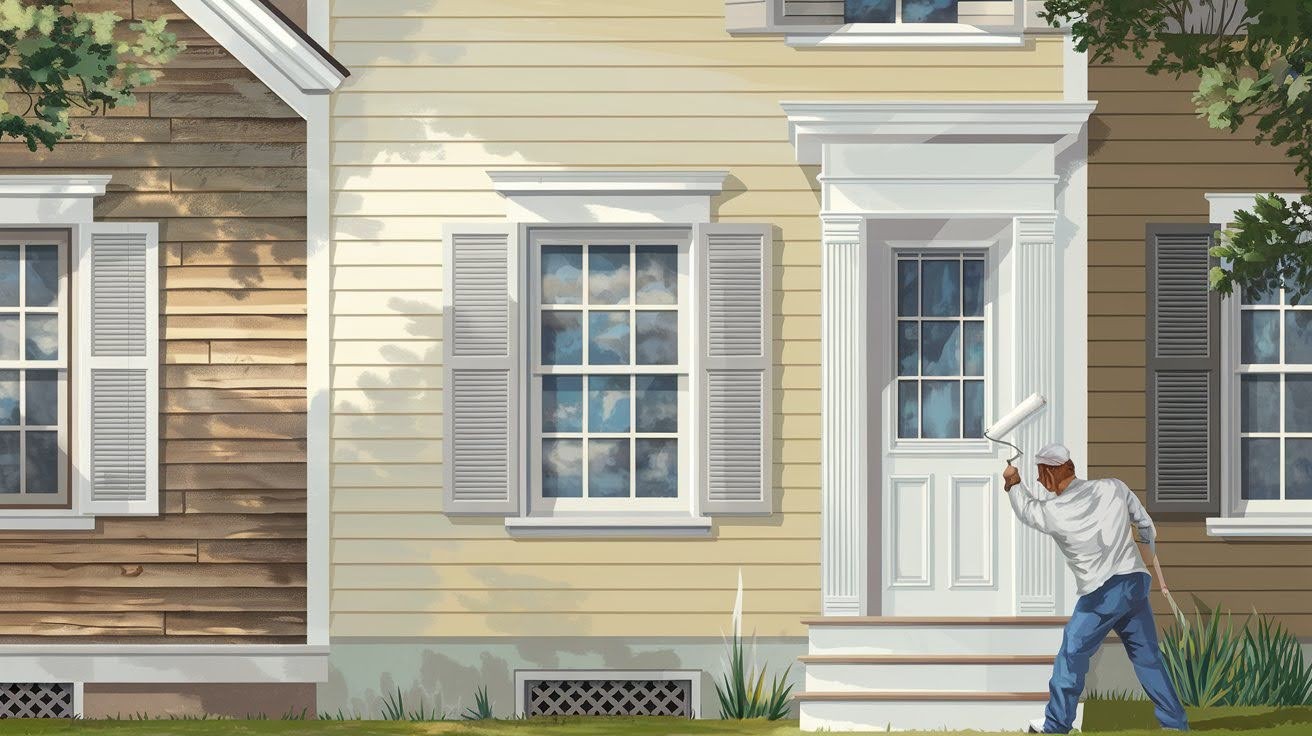
Exterior paints are built tough with special ingredients that fight weather, UV rays, and temperature changes for years.
Weather-Resistant Ingredients
I’ve learned that exterior paints pack a serious punch against Mother Nature.
Acrylic resins are the backbone. They flex with temperature changes without cracking. Cheap paints skip this ingredient.
UV blockers stop sun damage. Without them, your paint fades fast. I’ve seen red paint turn pink in just one summer.
But wait, there’s more protection.
Mildewcides fight mold and mildew. These chemicals keep your paint looking fresh in humid climates.
Alkyd resins add extra toughness. They help paint stick to surfaces better than water alone.
Titanium dioxide does double duty. It makes white paint white and reflects heat away from your house.
Durability And Lifespan
I expect exterior paint to last 7 to 10 years minimum. Quality matters here. Premium paints last 10 to 15 years. They cost more upfront but save money long-term.
Builder-grade paints fade and peel in 5 to 7 years. I learned this lesson the hard way.
Here’s what affects lifespan:
- Climate conditions
- Surface preparation
- Application method
- Paint quality
Wood siding needs repainting more often than vinyl or brick. The wood moves with weather changes.
South-facing walls take the most beating from sun. They may need touch-ups sooner.
Available Finishes And Textures
Exterior paint finishes work differently than indoor ones. I always consider the surface first.
Flat finish hides surface flaws well. But it’s harder to clean. I use it on older wood siding.
Satin finish is my favorite for most exteriors. It cleans easily and looks good.
But here’s the surprise.
Semi-gloss works great on trim and shutters. It highlights architectural details.
Gloss finish is too shiny for most homes. I only use it on front doors or metal railings.
Textured paints hide imperfections and add visual interest. They’re perfect for stucco or rough surfaces.
Some exterior paints come with built-in primer. This saves time but costs more upfront.
How Application Differs Between Interior And Exterior Paints
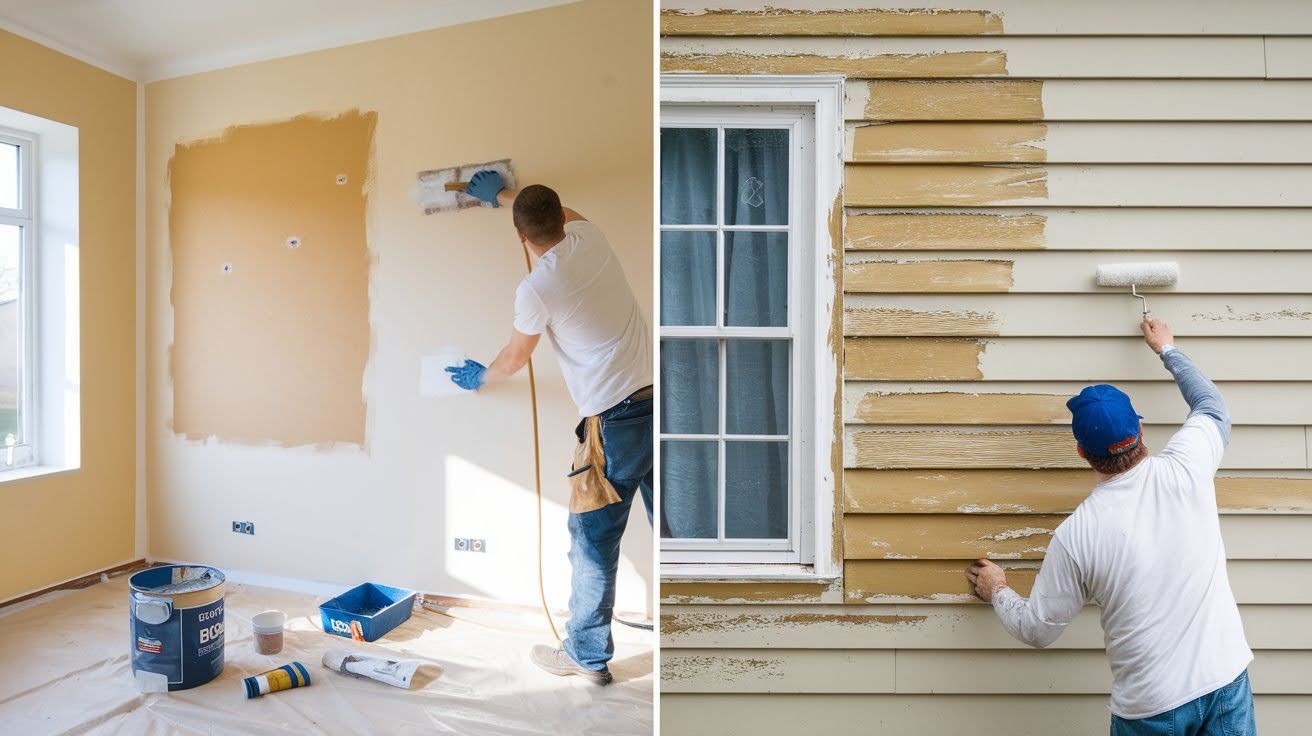
Interior and exterior painting require completely different prep work, tools, and techniques because of the surfaces and conditions involved.
Surface Preparation For Interior Painting
I always start with the basics indoors. Clean walls come first.
I use warm soapy water to remove dirt and grease. Kitchen walls need extra scrubbing. Crayon marks come off with a magic eraser.
Sanding smooths out imperfections. I use 220-grit sandpaper for most jobs. Don’t skip this step on glossy surfaces.
Here’s the thing though.
Priming makes or break your paint job. I prime over dark colors before going light. New drywall always needs primer first.
Small nail holes get spackling compound. Larger holes need a patch kit. I let everything dry completely before painting.
Surface Preparation For Exterior Painting
Outside prep work is more intense. I learned this after my first exterior paint job failed.
Pressure washing removes years of dirt and mildew. I use 1500 PSI for vinyl siding. Wood needs gentler pressure.
But wait, there’s a crucial step.
Scraping removes loose paint. I use a paint scraper and wire brush. This takes time but prevents future peeling.
Caulking fills gaps around windows and trim. Old caulk gets scraped out first. New caulk needs 24 hours to cure.
Priming is mandatory on bare wood and metal. I use oil-based primer on problem areas. It blocks stains better than water-based primers.
| Prep Step | Interior Process | Exterior Process |
|---|---|---|
| Cleaning | Soap and water, spot cleaning | Pressure washing entire surface |
| Surface Repair | Fill nail holes, light sanding | Scrape loose paint, heavy sanding |
| Priming | Spot prime repairs and dark colors | Prime all bare surfaces completely |
| Weather Considerations | Climate controlled environment | Check the forecast, avoid rain/wind |
| Drying Time | 2-4 hours between coats | 6-8 hours, depends on humidity |
| Tools Needed | Rollers, brushes, drop cloths | Sprayers, extension ladders, tarps |
Techniques For Using Interior Paint
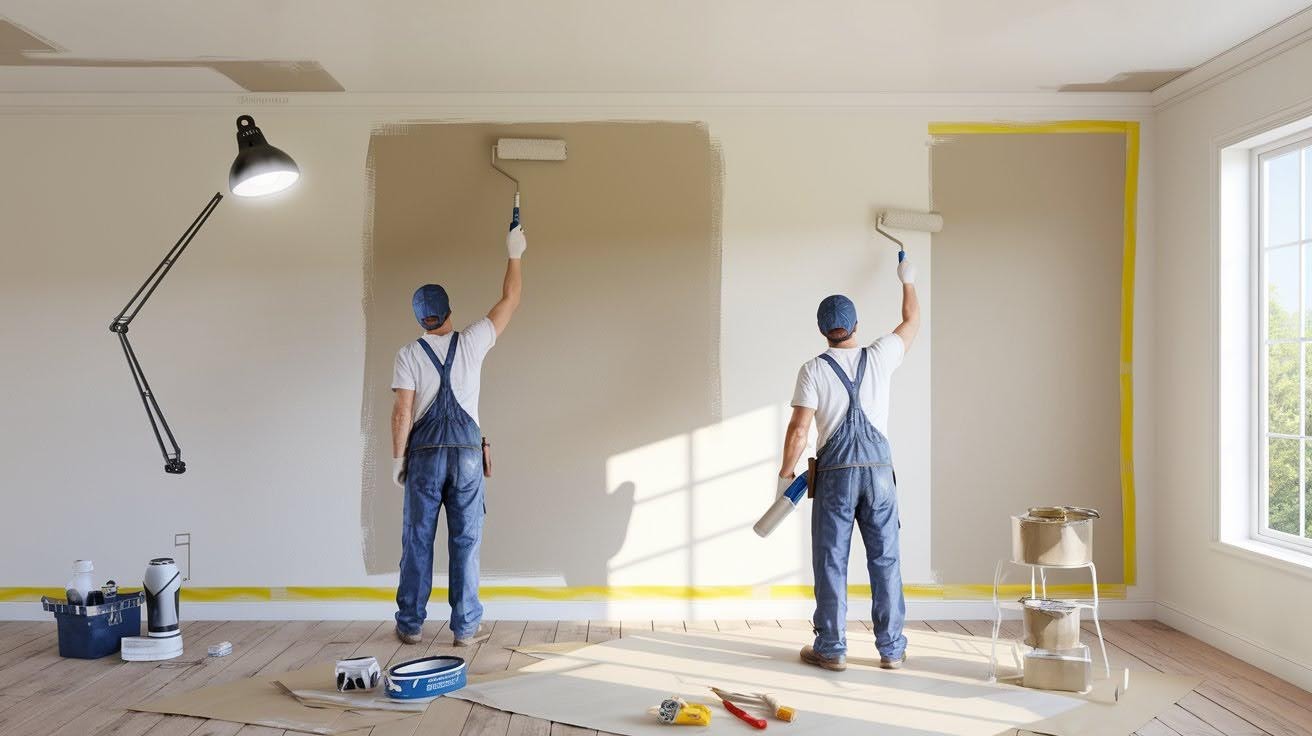
Start with the ceiling using a roller and extension pole. Cut in edges with a 2-inch angled brush before rolling walls.
Roll walls in a W pattern, then fill with parallel strokes. Work in 4-foot sections, maintaining a wet edge to avoid lap marks.
Use extra lighting to spot missed areas. Keep consistent roller pressure – too much creates texture issues, too little gives thin coverage.
Remove tape while paint is wet for crisp lines. Clean brushes immediately with soap and water for latex paint.
Maintain room temperature at 65-75°F with humidity below 70%. Apply two thin coats rather than one thick coat, letting the first dry completely.
This covers the key techniques that make the difference between amateur and professional-looking results.
Techniques For Using Exterior Paints
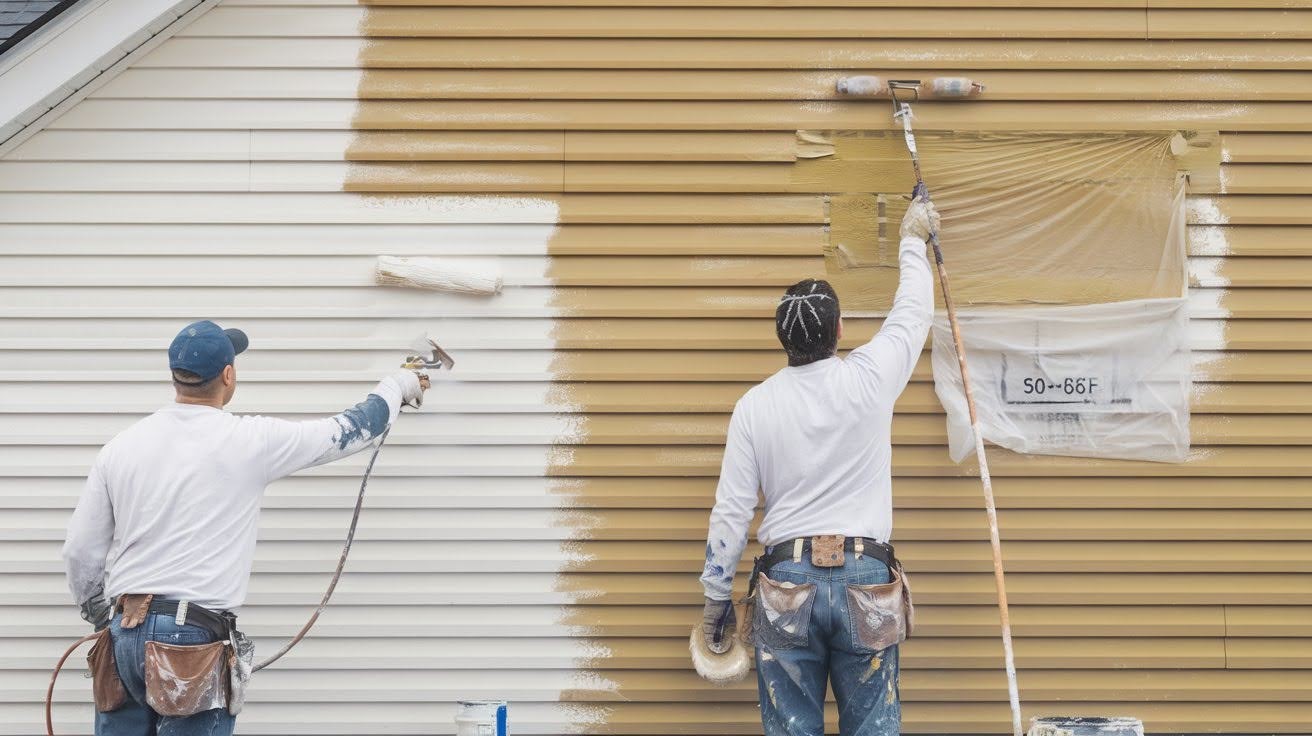
Check weather – avoid painting within 24 hours of expected rain or in winds over 10 mph. Paint in shade; direct sunlight dries paint too fast, causing lap marks.
Follow the sun around your house – start east in morning, move to north and west sides as day progresses.
Use a sprayer for large siding surfaces, back-rolling immediately for even coverage. Mask carefully – wind carries overspray farther than expected.
Work top to bottom in 6-foot sections maximum to maintain wet edges. Use extension poles instead of constantly moving ladders.
Apply thicker coats than indoors – exterior surfaces absorb more paint (one gallon covers 250 sq ft vs 400 inside). Clean tools frequently as exterior paint dries faster.
Paint in temperatures between 50-85°F. Hot surfaces cause bubbling and peeling.
The key differences from interior work: weather timing, thicker application, and working with the sun’s movement.
Factors To Consider When Choosing Interior And Exterior Paint
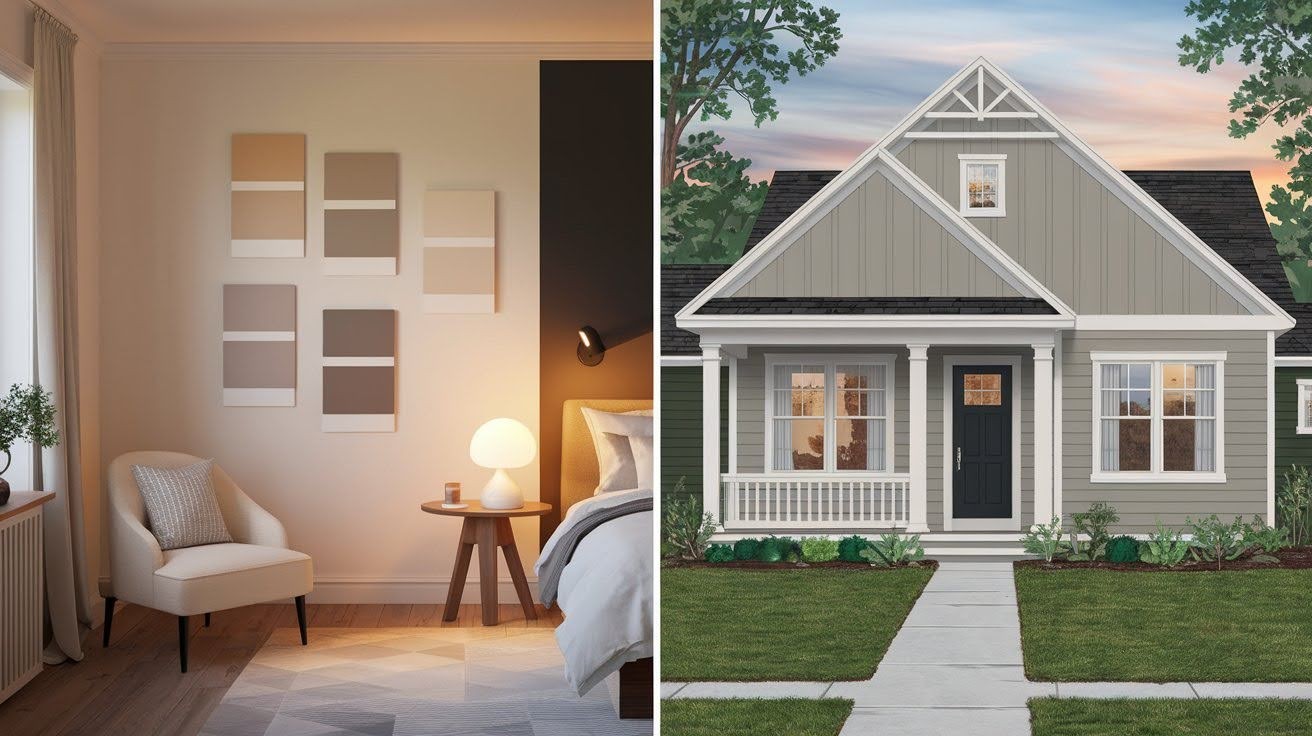
Smart paint selection depends on matching the right product to your specific needs, room conditions, and long-term goals.
Color And Finish Selection
I always test colors in different lighting before buying gallons of paint.
Interior colors affect your mood and room size. Light colors make small rooms feel bigger. Dark colors create cozy spaces but show dust easily.
Exterior colors must work with your roof and landscape. I stick to three colors maximum on the outside. Too many colors look busy.
But here’s what really matters.
Finish choice depends on the room’s function. I use flat paint in bedrooms where you don’t touch walls often. Semi-gloss works better in bathrooms and kitchens.
Color trends change but neutral colors hold value longer. I pick trendy colors for accent walls only.
HOA rules might limit your exterior color choices. Check before you buy paint. Some neighborhoods have strict color requirements.
Durability And Maintenance Requirements
I learned the hard way that cheap paint costs more long-term.
High-traffic areas need durable paint. Hallways and kids’ rooms get scuffed constantly. Washable paint saves time and money.
Climate affects exterior paint differently. Hot sun fades colors faster. Cold weather makes some paints crack.
Here’s the reality check.
Premium paints last twice as long as budget brands. I spend more upfront to avoid repainting every few years.
Oil-based paints are tougher but harder to clean up. Latex paints work fine for most jobs and clean with water.
Primer quality matters as much as paint quality. Good primer makes any paint last longer.
Budget And Cost Efficiency
I always calculate the total project cost before starting.
Paint price per gallon doesn’t tell the whole story. Coverage and longevity matter more. Cheap paint often needs three coats instead of two.
Labor costs can double your budget if you hire professionals. I do prep work myself and hire painters for the actual painting.
But there’s more to consider.
Quality brushes and rollers make cheap paint perform better. I invest in good tools that last for multiple projects.
Buying in bulk saves money on large projects. Many stores offer contractor discounts for multiple gallons.
Seasonal sales can cut costs by 30%. I stock up during fall and winter when demand drops.
Environmental And Health Impacts
Indoor air quality matters more than most people realize.
VOC levels affect your family’s health. I always choose low-VOC or zero-VOC paints for bedrooms and nurseries. Latex paints are more environmentally friendly than oil-based options. They contain fewer toxic chemicals and cleaned up with water.
Here’s what surprised me.
Recycled paint programs exist in many cities. You can get quality paint for half price while helping the environment. Disposal matters too. I never pour leftover paint down drains. Most hardware stores accept old paint for proper disposal.
Green certifications like Green Seal help identify safer products. These paints cost slightly more but protect your family’s health.
Quick Tips For Choosing The Right Paint
- Test colors in different lighting before buying full gallons. Paint looks different under morning sun versus evening lamps.
- Match finish to room function by using flat paint in bedrooms and semi-gloss in kitchens and bathrooms for easy cleaning.
- Check weather forecasts before exterior painting. Avoid painting when rain is expected within 24 hours or when winds exceed 10 mph.
- Invest in quality primer as it makes any paint last longer and provides better coverage than skipping this step.
- Choose low-VOC paints for bedrooms and nurseries to protect your family’s health and improve indoor air quality.
- Calculate total project costs including paint, primer, tools, and potential labor before starting any painting project.
- Work in small sections and maintain wet edges to avoid visible lap marks on both interior walls and exterior surfaces.
- Buy paint during off-season sales in fall and winter when demand drops to save up to 30% on quality products.
- Clean brushes immediately after use since dried paint ruins expensive tools and latex paint washes off easily with soap and water.
Conclusion
Choosing between interior and exterior paint isn’t just about picking colors you like. I’ve shown you that these paints are formulated completely differently for good reasons.
Interior paints focus on low odors, easy cleaning, and smooth finishes for comfortable living spaces. Exterior paints prioritize weather resistance, UV protection, and long-lasting durability against harsh conditions.
The prep work, application techniques, and maintenance requirements are vastly different too. Interior painting requires careful cutting and rolling in controlled conditions. Exterior painting demands weather timing, pressure washing, and heavy-duty surface preparation.
Remember to consider your specific needs: room function, climate conditions, budget constraints, and health concerns. Quality paint and proper technique always pay off in the long run.
Your paint job will look professional and last years longer when you match the right paint type to each specific project.
Frequently Asked Questions
Can I Use Exterior Paint Inside My House?
I don’t recommend using exterior paint indoors. Exterior paints contain higher levels of VOCs and chemicals that can cause headaches and breathing problems in enclosed spaces.
How Long Should I Wait Between Coats Of Paint?
Interior paint typically needs 2-4 hours between coats depending on humidity and temperature. Exterior paint requires 6-8 hours of drying time and should never be applied if rain is expected within 24 hours.
Do I Really Need To Prime Before Painting?
Yes, primer is essential for most painting projects. It helps paint stick better, covers stains, and ensures even color coverage, especially when going from dark to light colors or painting new surfaces.
What’s The Difference Between Flat And Semi-Gloss Paint?
Flat paint hides wall imperfections but is harder to clean, making it perfect for bedrooms and ceilings. Semi-gloss paint is more durable and washable, which makes it ideal for kitchens, bathrooms, and trim work.
How Much Paint Do I Need For My Project?
One gallon of interior paint covers about 400 square feet with one coat. Exterior paint covers roughly 250-300 square feet per gallon due to surface absorption, so always buy 10-15% extra for touch-ups.

